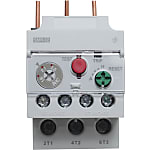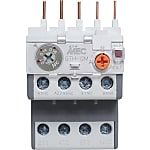(!)NOTE : Windows 7 users won’t be able to use some latest features of eCatalog/WOS since Microsoft is ending support for Windows 7 on 14 Jan, 2020. Please upgrade your system for uninterrupted services.
- Notice of End of Sales for Economy Series Pneumatic Equipment Category. More information.
Overload Relays(Auxiliary Contact:1a1b)
Brand |
|
|---|---|
| CAD |
|
| Days to Ship |
|
2 items
- Sort By
-
You can add up to 6 items per a category to the compare list.

MISUMI
A low cost thermal relay. Accessories can be easily installed.
- CAD :
- 2D
Motor Capacity VAC 200–220 Class(kW/A) Number of Poles Auxiliary Contact Representative Standard Dimension length(mm) Dimension width(mm) Dimension thickness(mm) 0.05/0.52 ~ 15/55 3 1a1b CE 73.2 ~ 80.6 45 ~ 55 63.7 ~ 100 From: ₹ 1,028.01 Days to Ship: 6 Day(s) or more  6 Day(s) or more
6 Day(s) or more
-
You can add up to 6 items per a category to the compare list.

Thermal Relay for Mini Contact
MISUMI
A thermal relay dedicated to mini contactors. Accessories can be easily installed.
- CAD :
- 2D
Motor Capacity VAC 200–220 Class(kW/A) Number of Poles Auxiliary Contact Representative Standard Dimension length(mm) Dimension width(mm) Dimension thickness(mm) - 3 1a1b CE 73.2 45 63.7 From: ₹ 848.18 Days to Ship: 6 Day(s) or more  6 Day(s) or more
6 Day(s) or more
| Brand |
|---|
| Product Series |
| CAD |
| From |
| Days to Ship |
| Specifications |
| Motor Capacity VAC 200–220 Class(kW/A) |
| Number of Poles |
| Auxiliary Contact |
| Representative Standard |
| Dimension length(mm) |
| Dimension width(mm) |
| Dimension thickness(mm) |
You can add up to 6 items per a category to the compare list. | You can add up to 6 items per a category to the compare list. | |
| Brand | MISUMI | MISUMI |
| Product Series | ||
| CAD |
|
|
| From | ₹ 1,028.01 | ₹ 848.18 |
| Days to Ship | 6 Day(s) or more | 6 Day(s) or more |
| Specifications | ||
| Motor Capacity VAC 200–220 Class(kW/A) | 0.05/0.52 ~ 15/55 | - |
| Number of Poles | 3 | 3 |
| Auxiliary Contact | 1a1b | 1a1b |
| Representative Standard | CE | CE |
| Dimension length(mm) | 73.2 ~ 80.6 | 73.2 |
| Dimension width(mm) | 45 ~ 55 | 45 |
| Dimension thickness(mm) | 63.7 ~ 100 | 63.7 |
Loading...
Configure
Specification/Dimensions
-
Motor Capacity VAC 200–220 Class(kW/A)
-
Number of Poles
- 3
-
Auxiliary Contact
- 1a1b
-
Representative Standard
-
Dimension length(mm)
-
Dimension width(mm)
-
Dimension thickness(mm)
Related Categories to Overload Relays
FAQ Overload Relays
- Question: What is the purpose of terminals 95 and 96 on an overload relay?
- Answer: In electrical systems, terminals 95 and 96 on an overload relay serve a crucial role in motor protection. Terminal 95 is the common terminal for the trip circuit, and terminal 96 is the normally close contact. When the overload relay detects excessive current in a motor, it activates the trip circuit. This action causes the normally close contact at terminal 96 to open, initiating protective measures, such as disconnecting the motor from the power supply, to prevent damage due to overcurrent.
- Question: How do overload relays contribute to electrical safety?
- Answer: Overload relays enhance electrical safety by monitoring motor currents. If currents exceed safe levels, the relay triggers protective actions, preventing motor overheating and potential fire hazards. By swiftly disconnecting power during overloads, they safeguard equipment, reduce downtime, and comply with safety standards. Overload relays offer early warnings of issues, allowing for timely maintenance. Customizable to specific current limits, they contribute to adaptability and seamless integration with control systems, ensuring efficient protection and reliable operation in various electrical applications.
- Question: What factors determine the correct setting for an overload relay?
- Answer: The correct overload relay setting depends on factors such as motor rating, type, and efficiency. Considerations include inrush current during startup, operating conditions, and load variations. Crucial aspects involve service factors, thermal models, and adherence to standards. Following manufacturer recommendations, finding a balance between protection sensitivity and avoiding unnecessary tripping is key. Regular reviews accommodate changes in the electrical system or equipment, ensuring optimal protection, compliance with standards, and reliability across various applications.
- Question: What role does an overload relay play in a 3-phase system?
- Answer: In a 3-phase system, an overload relay protects electric motors by monitoring current. When it detects excess current, signaling an overload, the relay activates a trip circuit that rapidly disconnects the motor. This prevents overheating, safeguarding the motor from damage and mitigating fire hazards. The overload relay contributes to overall system reliability, with adjustable settings and integration capabilities enhancing its adaptability and automation in motor protection.
- Question: How can the principle of overload be beneficial in relay design?
- Answer: The principle of overload in relay design is pivotal for electrical system safety. Overload relays, responsive to excessive current, disconnect power swiftly, preventing equipment damage and fire hazards. Adjustable settings accommodate diverse motor requirements, ensuring adaptability. Early warning features facilitate timely maintenance, minimizing downtime. This principle aligns with safety standards, promoting compliance. Beyond protection, overload relays contribute to energy efficiency by optimizing motor performance under varying loads. Overall, they play a crucial role in enhancing equipment longevity, system reliability, and adherence to safety regulations in electrical systems.
- Question: What distinguishes bimetallic overload relays from electronic types?
- Answer: Bimetallic and electronic overload relays differ in technology and performance. Bimetallic relays use physical expansion of bimetallic strips for current detection, providing simplicity but less precision. Electronic relays, employing sensors and microprocessors, offer higher sensitivity, adjustability, and advanced motor protection. While bimetallic relays are cost-effective for basic applications, electronic relays excel in complex systems, delivering enhanced performance, adaptability, and reliability. The choice depends on the application's needs, with bimetallic relays suited for simplicity and electronic relays for advanced functionality.








How can we improve?
How can we improve?
Thank you for your time.
Your feedback is essential for our continuous improvement
Privacy Policy
Thank you for your cooperation.
Thank you for your time.
Your feedback is essential for our continuous improvement
Please use the inquiry form.
Privacy Policy